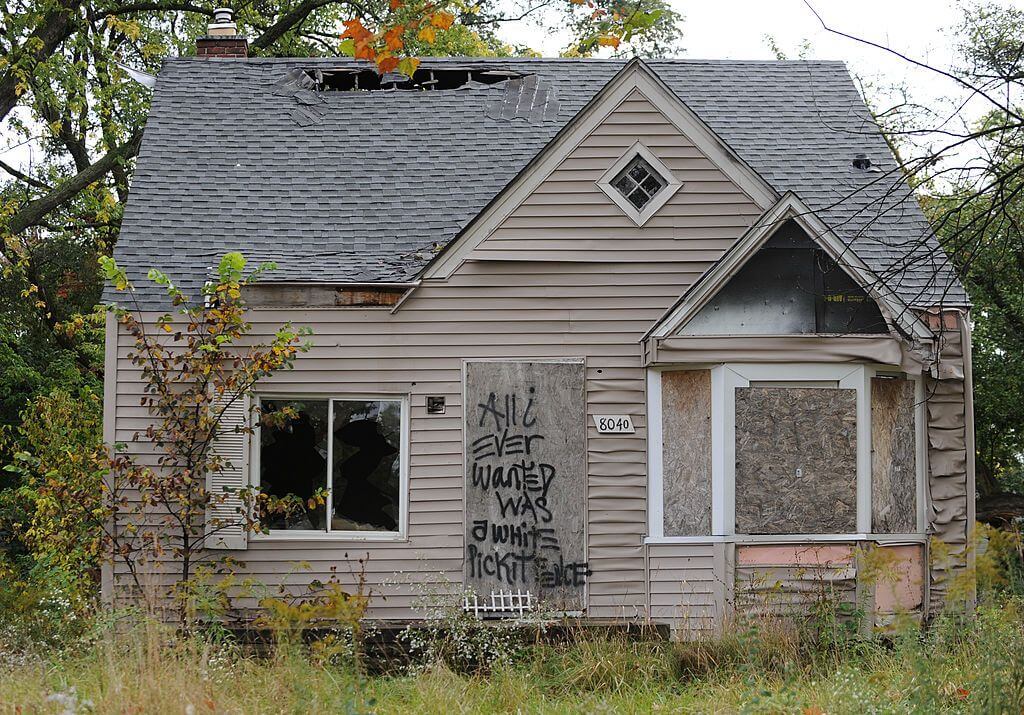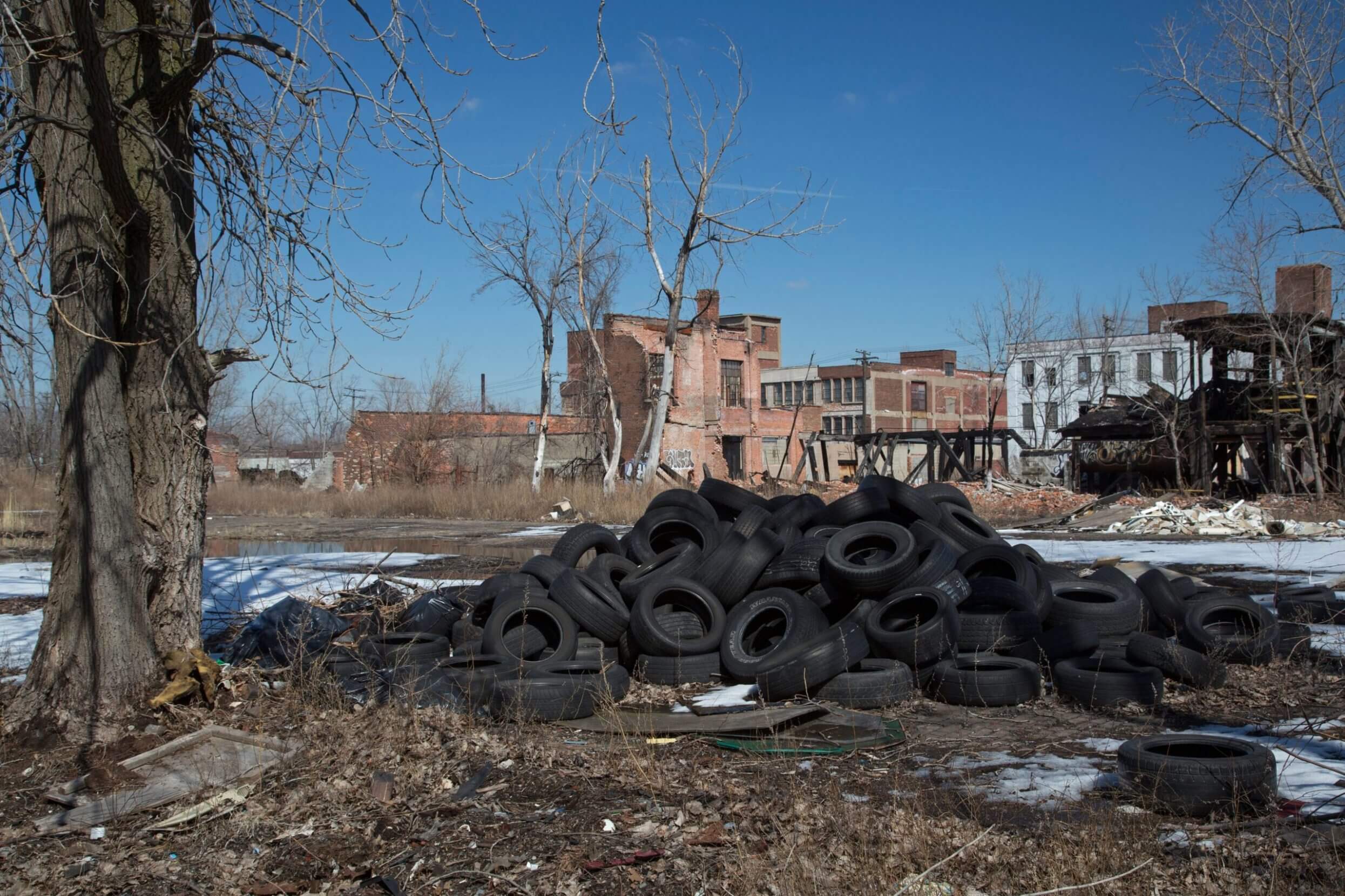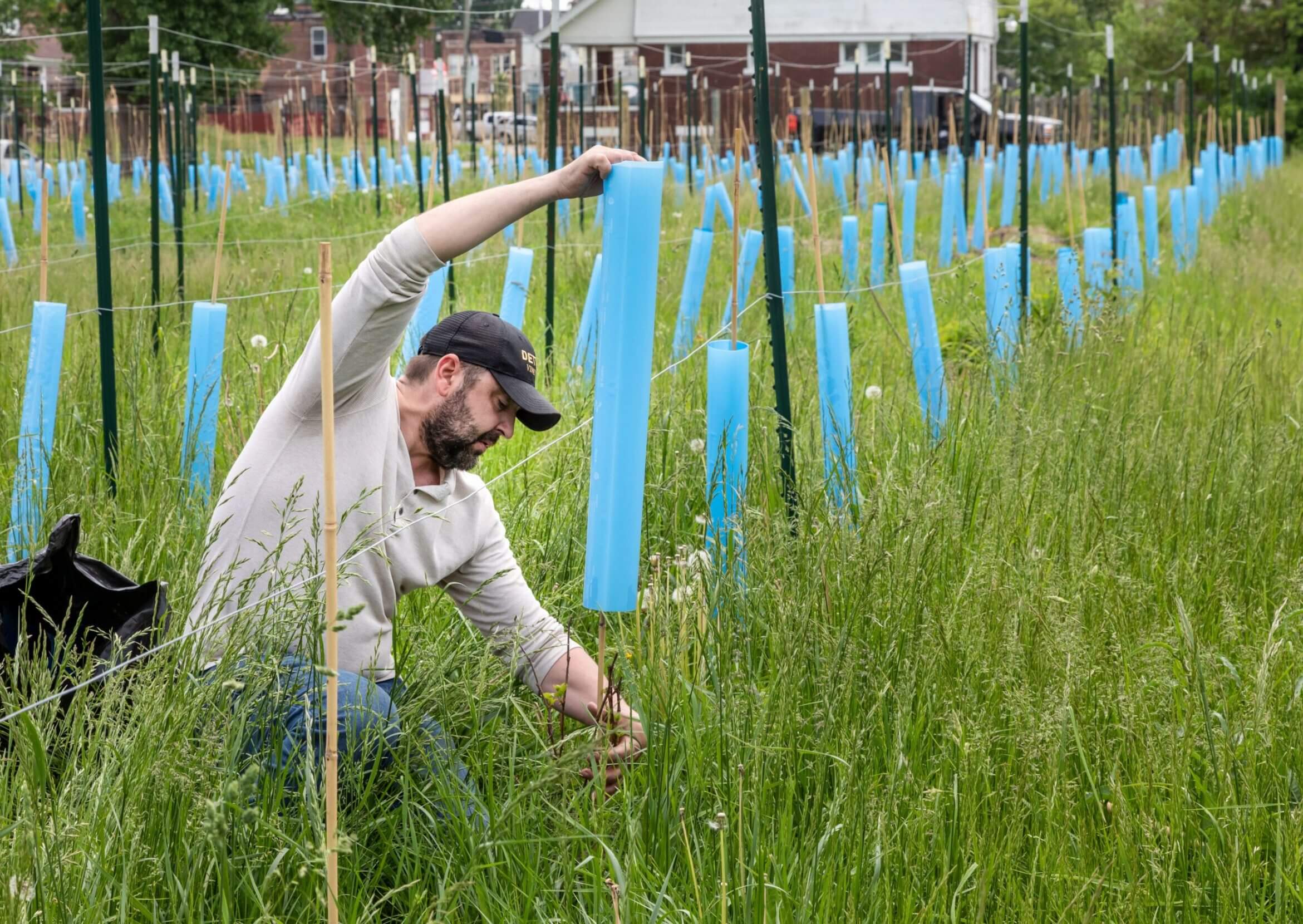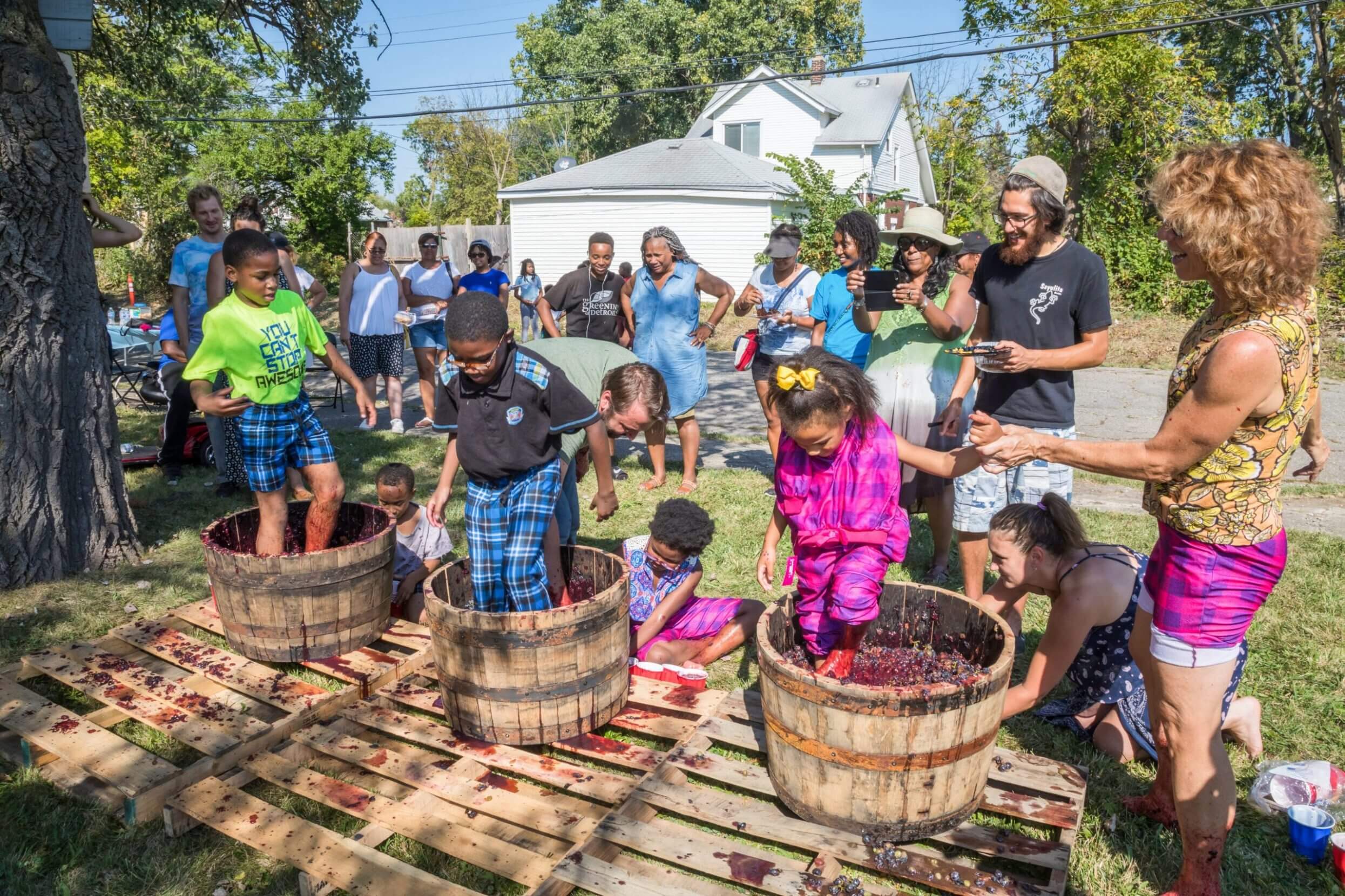In the Detroit that has been forgotten, where forlorn neighborhoods were destroyed by economic realities, there are abandoned homes.

‘All I ever wanted was a white picket fence.’ In the aftermath of Detroit’s long financial collapse, an urban wasteland of about 80,000 abandoned buildings and lots has emerged. PHOTO: MIRA OBERMAN/AFP/GETTY IMAGES
There are mounds of construction debris, dumped because it’s easier than regulated disposal; cars missing wheels and paint and parts; residents with hollow looks, and kids playing among the forgotten garbage of vacant lots. Every now and then, I find a spot of green, a bit of new growth, and manicured trellises reminiscent of a vineyard.
I have worked in the wine industry for more than 20 years. The kind of wine country I’m used to is one of rolling hills and winding roads, with fields of green slowly waving in light winds. Estate homes might dot the landscape and, depending on the time of year, vineyard workers are either pruning the vines coming out of a winter dormancy or, with grape knives flying, are picking the ripe grapes and tossing them in bins on the truck following behind their crew.
I have never seen wine grapes growing in a place like Detroit. But here in the blighted areas of the city, there are now vineyards. Some are butting up against extreme wealth (like the enclave of Grosse Pointe), but most are stuck in a maze of depressed neighborhoods.
These are petite urban vineyards that are new and struggling to take root. At this point, they are scrawny and brown, with offshoots of green leaves stretched tentatively along their supporting wire trellises. They are still a couple years from fruiting, but they are undeniably vineyards. In fact, there are 100,000 vines planted in Detroit’s marginal neighborhoods and, with 80,000 vacant lots in the city, there is plenty more room to grow. There’s even a winery downtown, where a Detroit local has grand plans for these seemingly far-fetched plantings.
~~
Well before the time of automobiles — Detroit’s most well-known industry over the last hundred years — Frenchman Antoine de la Mothe Cadillac established Detroit’s first vineyard. Planted in 1702, it was one of the first vineyards in North America.
I have never seen wine grapes growing in a place like Detroit. But here in the blighted areas of the city, there are now vineyards.
Cadillac found that the grapes he grew here, where Lake Erie, Lake St. Claire and the Detroit River meet, were “raisins de vigne avec peau mince et tres bon jus qui fera un vin excellent” — “thin-skinned wine grapes with a juice that will make excellent wine.” Because Detroit has those Burgundian-type, fog-influenced growing conditions that come with being close to water, and soil reminiscent of the limestone, clay, gravel, and sand necessary for French varietals like Pinot Noir and Chardonnay, it is not unreasonable to make wine here from local fruit.
But before these new petite vineyards, it had been a long time since grape vines were growing in Detroit. Once called the Renaissance City, Detroit prospered as flour milling, then shipbuilding, then automobile manufacturing fueled growth from the city’s founding in 1815 through the first half of the 20th century. Detroit became the home of the automotive industry in the U.S. and was heralded as “the Paris of the West” for its wealth and culture, beautiful mansions, and museums.
The decline of Detroit came in the second half of the century. The decline’s causes were complicated, but its effects were stark and disturbingly simple. From 1950 to 1960, Detroit lost almost a tenth of its population, and the trend continued through subsequent decades. American automobile companies, losing market share to foreign manufacturers, shuttered factories. Despite periodic reprieves, unemployment rates consistently outpaced the national average. And when the Great Recession of 2007-2009 hit, an already struggling Detroit crumbled. Once the fourth largest city in the country, by 2010 the Paris of the West ranked barely 18th and bankruptcy wasn’t far behind.

In what was once called ‘The Paris of the West,’ many abandoned homes are awaiting demolition. PHOTO: JAMES CHEADLE / ALAMY
Some say that Detroit is going through a second renaissance. The downtown area is dotted with cranes, soaring hotels, and business towers; it’s buzzing with new construction. There’s a chatter of passersby on the main drag, which is heaving with new restaurants and retail spaces.
But head away from this buzzy scene and it’s clear that much of the city is still devastated. In many neighborhoods, those former mansions sit empty, impossible to repair or too expensive to fix, and slated to be demolished. Smaller homes, too, were abandoned and many have been torn down, leaving empty lots. Detroit now has more than 80,000 vacant lots. Quite a few have become dumping grounds. All of them cast a pall on the neighborhoods where residents stuck out the collapse of the city around them only to be rewarded with crime, loss in property value, and little hope for a different future.

Among the tens of thousands of vacant lots throughout the city, urban vineyards are sprouting up. PHOTO: JIM WEST / ALAMY
But when Blake Kownacki looks at these vacant lots, he sees possibility.
~~
Kownacki was doing fine, making wine and seeing the world as a winemaker: He had a successful career first in organic farming, then producing vintages in Paso Robles, California, and Australia. But his roots and family in Michigan were calling him back.
Kownacki is an affable guy in his forties, with a full beard and a cheerful management style that includes the directive to “have fun.” When he first moved back to his home state, he managed a winery in the Traverse City area — where most Michigan wineries are based — for several years. At that point, wineries in Detroit were unheard of.
That was until this year, when Detroit Vineyards took the old Stroh’s ice cream factory smack in downtown Detroit and turned it into a production, event, and wine-tasting facility. Though Detroit Vineyards began producing wine in 2016 in Kownacki’s garage, the move to downtown was significant: They sit next to the large, historic Eastern Market, so foot traffic is steady. The winery has been an undeniable success. And as if in a nod to Antoine de la Mothe Cadillac, Detroit Vineyards uses the classic French vintner practices of making natural unfiltered and unfined wines.
With an urban winery, production is on site. Currently, Kownacki sources fruit from the established American Viticultural Areas (AVAs) in Michigan, like Traverse City. But, with the opening of the winery, production will increase from 1,200 to 12,000 cases in a year. While sourcing from established vineyards will surely continue, Kownacki, driven to break boundaries and defy expectations, has a plan to bring in truly local fruit — grown within the city.
Those vacant lots that reflect blight are perfect for small vineyards, says Kownacki. The land is cheap, and the location — as Monsieur Cadillac found 300 years ago — yields excellent grapes. If vineyards are planted on this neglected land and Detroit Vineyards guides neighborhood owners on planting, care, and cultivation of grapevines, it’s a win-win for both the winery and Detroit’s residents.

Blake Kownacki of Detroit Vineyards plants grape vines in the MorningSide neighborhood. PHOTO: JIM WEST / ALAMY
“I thought, ‘What can our company do to improve this situation where the revitalization of Detroit has been concentrated on the Woodward Corridor and has left 130 out of 140 square miles out of the benefit area?’” says Kownacki. “We chose to work with the people who remained here and work toward eradicating blight and raising their property values.”
As Detroit’s urban vineyards continue to grow, Kownacki is getting closer to his dream. But around 2010, when he first started sitting down with a glass of wine and dropping his “vacant lot vineyard” vision into conversations, nearly everyone dismissed him.
It was, after all, a ridiculous idea.
~~
To make Detroit Vineyards a reality, Kownacki partnered with Dr. Claes Fornell, a University of Michigan professor with a small vineyard who served on the Michigan Wine and Grape Council. Kownacki had helped Dr. Fornell with his small vineyard in Ann Arbor. Over time, they realized that their discussions of making wine and growing grapes in the urban center of Detroit would become more than fantasy. Dr. Fornell believed in both Kownacki and the project. They would build Detroit Vineyards to be more than a winery.
City officials were skeptical, but Kownacki is a man with moxie. He had a gut feeling that, little by little, he would break down the resistance of those who dismissed, laughed at, or ignored him. His silent partner, Dr. Fornell, was a believer now — surely there were more. Kownacki became known as the “one who wouldn’t go away.”
“Nine years ago, when I started this project, I was considered crazy,” says Kownacki. “Now I am not so crazy. A vacant lot is $100, and we will help you plant and care for a vineyard! Once it is productive, I will buy the fruit — so it is an investment property, beautifies the neighborhood and raises property values. We don’t need to own the land: We just want the grapes. That means about $1,500 in the vineyard owner’s pocket annually.”
It took years to make progress, but with the support of believers like Dr. Fornell, employees who jumped on board, and, eventually, city officials, Kownacki’s tenacity has begun to pay off: The staff at the winery has grown to 20 and, since opening in May 2019, they are barely able to catch their breath between marketing the wine and fielding media inquiries.
One of those 20 employees is dedicated solely to community outreach. I have never seen this position, even in much bigger wineries. That is the commitment of this group.
Shortly after opening, Detroit Vineyards held a community planting party with a DJ, a bouncy house for the kids, and BBQ for everyone. They have held urban grape stomps that engage adults and kids.

Grape stomping contests at a block party are one of the ways in which the vineyards are cultivating the community in the MorningSide neighborhood. PHOTO: JIM WEST / ALAMY
“The neighborhood gets into it, digs the project, and watches out for the vineyards,” Kownacki says. “I am far more worried about birds and deer damaging the vines than I am about people.”
~~
Thomas Roberes first met Kownacki at Home Depot. It was 2016, and Roberes was working part-time when he and Kownacki struck up a conversation about urban gardening.
“We talked, and he wanted to check out my urban garden,” Roberes says. “When he saw it, he was amazed and wanted me to work with him on the vineyard project. I was very interested … I had never heard of any idea like this ever done in this city.”
“This is a collaborative community effort,” says Kownacki. “I want to see individuals who live here, the ones who stayed, benefit from our winery.”
Roberes became Detroit Vineyards’ full-time Community Outreach Coordinator in August 2018. The position largely consists of winning people over.
Roberes points to a skeptical president of the MorningSide Community where Detroit Vineyards, with the help of non-profit U-Snap-Bac, planted the largest urban vineyard to date. After watching Roberes and Kownacki go door-to-door and answer questions, the community leader did an about-face and helped find the space to host their neighborhood planting event.
“After the residents get over the shock factor that a vineyard is being put in their neighborhood, they learn all the benefits of a community vineyard, and their shock turns into curiosity,” says Roberes.
Detroit Vineyards is focused on shaking up not just the people involved, but also the plants. Although in its infancy, their non-profit planting project is making inroads with 1,000 vines of a cold-tolerant varietal called Marquette, a hybrid cross between a native North American grape and traditional vinifera.
What’s more, Kownacki doesn’t plan on stopping at vacant lots. He hopes to plant near the water, where his analysis shows Burgundian varietals like Pinot Noir and Chardonnay will flourish. He eyes an underutilized waterfront park that would be perfect for grape-growing education and community engagement. This, of course, will take even more massaging of city managers. But Detroit has a history of 150 years of farming, and Kownacki loves returning to those roots, making the concept of farming fun and profitable.
“This is a collaborative community effort,” says Kownacki. “I could buy up parcels of land, but that is not how we roll. I want to see individuals who live here, the ones who stayed, benefit from our winery.”
Kownacki might have been the first to see this kind of hope in Detroit’s vacant lots, but he certainly won’t be the last.
“Grape growing is not glamorous: it is farming,” he says. “But I want kids to know that … once you learn the skill set, you can harvest anywhere.”
Barbara Barrielle
Barbara Barrielle writes about wine and travel and is an equal opportunity traveler. She loves to go everywhere and meet the locals, the heart of travel.



